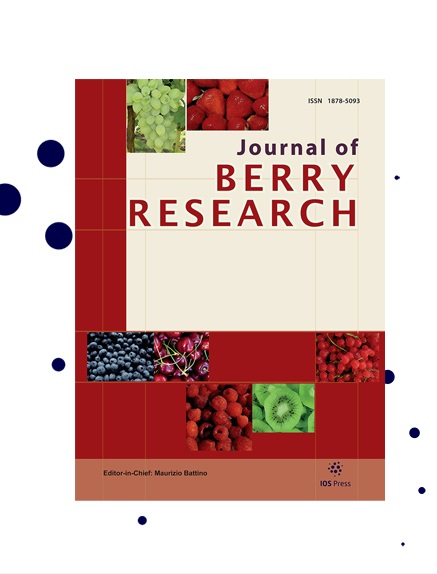高丛蓝莓与沙山波杂交果实发育各阶段多酚含量、抗氧化活性及抗癌细胞增殖特性
IF 1.4
4区 农林科学
Q3 PLANT SCIENCES
引用次数: 6
摘要
背景:蓝莓及其近缘种果实的总多酚含量、总花青素含量和抗氧化活性是蓝莓育种的重要指标。近年来,利用多倍体育种技术,首次培育出日本野生品种沙山伯与高丛蓝莓的杂交品种。然而,对这些杂交品种果实的多酚含量、抗氧化活性和抗癌细胞增殖特性的研究还不够充分。目的:测定交交杂交种果实发育各阶段花青素含量、多酚含量及抗氧化活性,并以人早幼粒细胞白血病(HL-60)细胞为研究对象,研究交交杂交种果实提取物对肿瘤细胞增殖特性的影响。方法:采用3个交系杂交种及其亲本在5个发育阶段的冻干果实样品,评价其多酚含量、花青素含量以及两种抗氧化活性(DPPH和ORAC)水平。并根据HL-60细胞的存活率评价各提取物的抗癌细胞增殖性能。结果:杂交杂交种果实中总多酚含量随着果实的生长逐渐降低,但在成熟期略有增加。同时,总花青素含量在成熟期显著增加。此外,交叉杂交JM1果实提取物对HL-60人白血病细胞的体外抑制效果更明显。总多酚含量与抗氧化活性和抗癌细胞增殖特性高度相关。结论:本研究明确了杂交产物具有丰富的生物活性化合物、高水平的抗氧化活性和抗癌细胞增殖特性。结果表明,利用日本野生蓝莓种质资源选育具有高活性成分的蓝莓是有效的。本文章由计算机程序翻译,如有差异,请以英文原文为准。
Polyphenol contents, antioxidant activities, and anti-cancer cell proliferation properties at each stage of fruit development in intersectional hybrids between highbush blueberry and shashanbo (Vaccinium bracteatum Thunb.)
BACKGROUND: In blueberries, the total polyphenol contents, total anthocyanin contents, and antioxidant activities of fruits in blueberries and their relatives are becoming important targets for breeders. Recently, intersectional hybrids between Japanese wild species Shashanbo and highbush blueberry were produced using polyploid breeding for the first time. However, the polyphenol contents, antioxidant activities, and anti-cancer cell proliferation properties of the fruits of these intersectional hybrids have not been studied sufficiently. OBJECTIVE: The objectives of this study were to determine the anthocyanin contents, polyphenol contents, and antioxidant activities at each stage of fruit development in intersectional hybrids, and to examine the effects of the fruit extracts on anti-cancer cell proliferation properties using human promyelocytic leukemia (HL-60) cells. METHODS: Freeze-dried fruit samples of three intersectional hybrids and their parents at five developmental stages were used to evaluate their polyphenol contents, anthocyanin contents, and levels of two types of antioxidant activities (DPPH and ORAC). The anti-cancer cell proliferation properties of each extract were also evaluated according to the survival rate of HL-60 cells. RESULTS: The total polyphenol contents in fruits of the intersectional hybrids gradually decreased as the fruits grew, but the contents increased slightly at the mature stage. Meanwhile, the total anthocyanin contents increased strongly to the mature stage. In addition, the fruit extract of intersectional hybrid JM1 was found to be more effective for inhibiting the growth of HL-60 human leukemia cells in vitro. Total polyphenol content correlated highly with antioxidant activities and anti-cancer cell proliferation properties. CONCLUSIONS: We clarified that the intersectional hybrids had produced have abundant bioactive compounds, high levels of antioxidant activities, and anti-cancer cell proliferation properties. The results proved the effectiveness of the use of Japanese wild Vaccinium species for the strategic breeding of blueberries with high levels of bioactive compounds.
求助全文
通过发布文献求助,成功后即可免费获取论文全文。
去求助
来源期刊

Journal of Berry Research
Biochemistry, Genetics and Molecular Biology-Biochemistry
CiteScore
3.50
自引率
11.80%
发文量
21
期刊介绍:
The main objective of the Journal of Berry Research is to improve the knowledge about quality and production of berries to benefit health of the consumers and maintain profitable production using sustainable systems. The objective will be achieved by focusing on four main areas of research and development:
From genetics to variety evaluation
Nursery production systems and plant quality control
Plant physiology, biochemistry and molecular biology, as well as cultural management
Health for the consumer: components and factors affecting berries'' nutritional value
Specifically, the journal will cover berries (strawberry, raspberry, blackberry, blueberry, cranberry currants, etc.), as well as grapes and small soft fruit in general (e.g., kiwi fruit). It will publish research results covering all areas of plant breeding, including plant genetics, genomics, functional genomics, proteomics and metabolomics, plant physiology, plant pathology and plant development, as well as results dealing with the chemistry and biochemistry of bioactive compounds contained in such fruits and their possible role in human health. Contributions detailing possible pharmacological, medical or therapeutic use or dietary significance will be welcomed in addition to studies regarding biosafety issues of genetically modified plants.
 求助内容:
求助内容: 应助结果提醒方式:
应助结果提醒方式:


